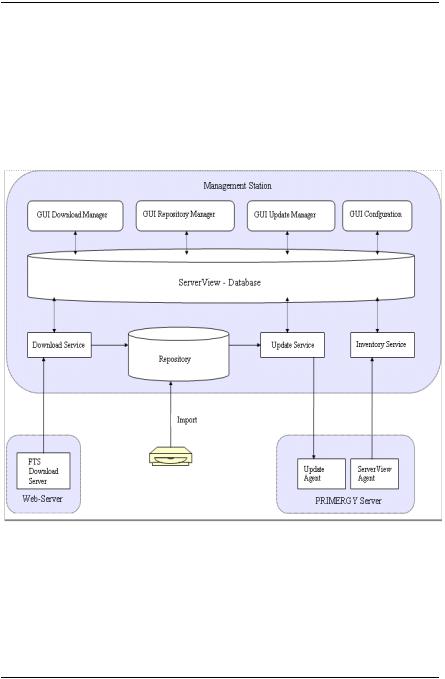FUJITSU ServerView Suite User Manual

User Guide - English
Fujitsu Software ServerView Suite
ServerView Update Management
ServerView Operations Manager V6.20
Edition June 2013
Comments… Suggestions… Corrections…
The User Documentation Department would like to know your opinion of this manual. Your feedback helps us optimize our documentation to suit your individual needs.
Feel free to send us your comments by e-mail to manuals@ts.fujitsu.com.
Certified documentation according to DIN EN ISO 9001:2008
To ensure a consistently high quality standard and user-friendliness, this documentation was created to meet the regulations of a quality management system which complies with the requirements of the standard DIN EN ISO 9001:2008.
cognitas. Gesellschaft für Technik-Dokumentation mbH
www.cognitas.de
Copyright and trademarks
Copyright © 1998 - 2013 Fujitsu Technology Solutions.
All rights reserved.
Delivery subject to availability; right of technical modifications reserved.
All hardware and software names used are trademarks of their respective manufacturers.

Contents
Contents |
3 |
1 Introduction |
9 |
1.1 Concepts |
10 |
1.2 Prerequisites |
12 |
1.2.1 Prerequisites on managed servers |
12 |
1.2.2 Prerequisites on connection blades |
15 |
1.2.3 Prerequisites on systems with operating system ESXi (flash |
|
via iRMC S3 using cURL) |
15 |
1.2.4 Prerequisites on TFTP server |
16 |
1.2.5 Prerequisites on the Central Management Station (CMS) |
17 |
1.2.5.1 Update Management Logon (OS=Windows) |
17 |
1.2.5.2 Configuration of Update Management (Repository, …) |
19 |
|
|
1.2.5.3 Update Data |
19 |
1.3 Notes on management stations |
21 |
1.3.1 Shutdown and restart |
21 |
1.3.1.1 Status after unplanned restart |
21 |
1.3.1.2 Procedure for resolving the errors |
21 |
1.3.2 Updating the management station with components which |
|
needs a reboot |
21 |
1.3.3 Multiple management stations |
22 |
1.4 Autonomous Support Packages (ASP) |
22 |
1.5 PRIMERGY Support Packages (PSP) |
22 |
1.5.1 Current PSP versions |
22 |
1.5.2 Components of a PSP |
23 |
1.5.3 Product Detection of Primergy Support Packages |
24 |
1.5.4 Initial Installation of Primergy Support Packages |
26 |
1.6 Notes on deleting servers from the ServerList |
27 |
1.7 Typographic conventions |
28 |
1.8 ServerView Suite link collection |
29 |
1.9 Documentation for the ServerView Suite |
30 |
2 Overview |
33 |
3 Update Procedures |
37 |
3.1 Online update |
38 |
3.2 Update via TFTP server |
40 |
ServerView Update Management |
3 |

Contents
3.2.1 Updating a hardware system |
41 |
3.2.2 Updating a system running a VMware ESXi operating sys- |
|
tem (flash via iRMC S3 using cURL) |
43 |
3.3 Access to update data |
45 |
4 Installing ServerView Update Agents |
47 |
4.1 Installation on the managed server |
47 |
4.1.1 Requirements for installation |
47 |
4.1.2 Requirements for uninstallation |
48 |
4.1.3 Installing Update Agent V6.0 (or later) |
49 |
4.1.3.1 Installation under Windows |
49 |
4.1.3.2 Installation under Linux or VMWare (ESX) |
52 |
4.2 Installation on the TFTP server |
55 |
4.2.1 Installation under Windows |
55 |
4.2.2 Installation under Linux |
56 |
5 User Interface |
57 |
5.1 Update Manager Main Window |
57 |
5.1.1 The tree structure |
60 |
5.1.2 Server Details tab |
65 |
5.1.3 Update Details tab |
71 |
5.1.4 Job Details tab |
76 |
5.1.5 Dialog boxes and wizards |
80 |
5.1.5.1 LogOn dialog box |
81 |
5.1.5.2 Cleanup Wizard |
84 |
5.1.5.3 Server Details dialog box |
89 |
5.1.5.4 Create Job Wizard |
95 |
5.1.5.5 Update Details dialog box |
106 |
5.1.5.6 PSP Details dialog box |
110 |
5.1.5.7 Copy Job Wizard |
112 |
5.1.5.8 Job Details dialog box |
124 |
5.1.5.9 Edit Job dialog box |
127 |
5.1.5.10 Change TFTP Address dialog box |
130 |
5.2 Repository Manager Main Window |
132 |
5.2.1 The tree structure |
133 |
5.2.2 Updates tab |
135 |
5.2.3 Collections tab |
139 |
5.2.4 Dialog boxes |
142 |
5.2.4.1 Edit Update's Properties dialog box |
142 |
4 |
ServerView Update Management |

Contents
5.2.4.2 Import Repository Components dialog box |
146 |
5.2.4.3 Import Repository Components - Results dialog box |
149 |
5.2.4.4 Export Repository Components dialog box |
151 |
5.2.4.5 Export Repository Components - Results dialog box |
153 |
5.2.4.6 Delete Repository Components dialog box |
155 |
5.2.4.7 Delete Repository Components - Results dialog box |
157 |
5.2.4.8 PSP Details dialog box |
159 |
5.2.4.9 Create Collection dialog box |
161 |
5.2.4.10 Edit Collection dialog box |
163 |
5.3 Download Manager Main Window |
165 |
5.3.1 The tree structure |
166 |
5.3.2 Task Management Tab |
167 |
5.3.3 Scheduled Tasks Tab |
170 |
5.3.4 Log Files Tab |
172 |
5.3.5 Dialog boxes |
175 |
5.3.5.1 Add Download Server Tasks dialog box |
175 |
5.3.5.2 Edit Download Server Tasks dialog box |
178 |
5.3.5.3 Activate Download Server Tasks dialog box |
180 |
5.4 Configuration Main Window |
182 |
5.4.1 General Settings Tab |
183 |
5.4.2 Mail Settings Tab |
185 |
5.4.3 Download Settings Tab |
187 |
5.4.4 Configuration Wizard |
189 |
5.4.4.1 Start step (Configuration Wizard) |
190 |
5.4.4.2 Repository step (Configuration Wizard) |
191 |
5.4.4.3 Miscellaneous step (Configuration Wizard) |
196 |
5.4.4.4 Download Settings step (Configuration Wizard) |
197 |
5.4.4.5 Mail Settings step (Configuration Wizard) |
199 |
5.4.4.6 Activate step (Configuration Wizard) |
201 |
5.5 Filter dialog box |
203 |
5.5.1 Standard (Filter dialog box) |
203 |
5.5.2 Character strings (Filter dialog box) |
204 |
5.5.3 Integer values (Filter dialog box) |
205 |
6 Managing Updates |
207 |
6.1 Update Manager |
207 |
6.1.1 Opening Update Manager |
207 |
6.1.2 Closing Update Manager |
208 |
6.1.3 Logging on to the Server |
208 |
ServerView Update Management |
5 |

Contents
6.1.4 Resetting the update agent of a server |
209 |
6.1.5 Displaying the update log for a server |
211 |
6.1.6 Displaying detailed information about an update |
211 |
6.1.7 Managing jobs |
211 |
6.1.7.1 Creating a job |
211 |
6.1.7.2 Copying a job |
213 |
6.1.7.3 Releasing a job |
215 |
6.1.7.4 Deleting a job |
215 |
6.1.7.5 Displaying detailed information about a job |
215 |
6.2 Repository Manager |
216 |
6.2.1 Opening Repository Manager |
216 |
6.2.2 Closing Repository Manager |
216 |
6.2.3 Editing updates |
217 |
6.2.4 Releasing updates |
217 |
6.2.5 Managing user-defined groups (Collections) |
218 |
6.2.5.1 Creating a user-defined group |
218 |
6.2.5.2 Editing a user-defined group |
218 |
6.2.5.3 Releasing updates in a user-defined group |
219 |
6.2.5.4 Deleting a user-defined group |
219 |
6.2.6 Re-Initializing the Repository |
220 |
6.3 Download Manager |
222 |
6.3.1 Adjusting the Download Service |
222 |
6.3.2 General Information on Download Manager |
223 |
6.3.3 Opening Download Manager |
224 |
6.3.4 Closing Download Manager |
224 |
6.3.5 Creating a new download task |
224 |
6.3.6 Assigning servers to a download task |
225 |
6.3.7 Editing a download task |
225 |
6.3.8 Deleting a download task |
226 |
6.3.9 Monitoring download tasks |
226 |
6.3.10 Managing log files |
227 |
6.4 Configuration |
227 |
6.4.1 Opening the configuration |
227 |
6.4.2 Closing the configuration |
228 |
6.4.3 Setting Global Parameters |
228 |
6.5 Filtering a table |
232 |
7 Command-Line Interface |
233 |
7.1 GFCLI (Command-Line Interface) |
233 |
6 |
ServerView Update Management |

Contents
7.1.1 Call Parameters |
234 |
7.1.2 StartFlash (Command) |
237 |
7.1.3 WaitForDone (Command) |
240 |
7.1.4 Reboot (Command) |
242 |
7.1.5 Cleanup (Command) |
244 |
7.1.6 Cancel (Command) |
245 |
7.1.7 Result Files |
247 |
7.1.7.1 StartFlash (Event) |
248 |
7.1.7.2 Ready (Event) |
251 |
7.1.7.3 Cancel (Event) |
252 |
7.1.7.4 SequenceError (Event) |
252 |
7.1.7.5 ParamError (Event) |
253 |
7.1.7.6 LogonError (Event) |
253 |
7.1.7.7 MemoryError (Event) |
253 |
7.1.8 Batch Files (Examples) |
254 |
7.1.9 CLI Standalone |
267 |
7.2 citfs.bat (batch job) |
267 |
8 Troubleshooting |
271 |
8.1 Error messages in the Update Manager |
271 |
8.2 Error messages in the Download Manager |
276 |
8.3 Error messages in the Configuration Wizard |
280 |
8.4 Error messages in the Repository Manager |
283 |
8.5 Problems with Single Sign-On |
283 |
8.6 Problems with Logon |
283 |
8.7 Problems with entries in the tree structure |
285 |
8.8 Problems with components |
286 |
8.9 Problems with Fibre Channel (FC) Controllers |
287 |
8.10 Event ID 2370 on managed node |
287 |
8.11 Installation/Uninstallation of updateable components without |
|
using Update Manager |
289 |
Index |
291 |
ServerView Update Management |
7 |

8 |
ServerView Update Management |

1 Introduction
ServerView Update Management allows you to manage updates for the firmware and software components of PRIMERGY servers. Update Management comprises the following applications:
•Update Manager provides a mechanism for managing updates and installing them on the monitored managed nodes.
•Repository Manager provides a mechanism for managing the repository:
o |
view a list of updates contained in the repository |
o |
change properties of contents |
o |
update your local repository on the management station |
o |
create collections |
•Download Manager provides a mechanism for checking for available updates and downloading new ones for the monitored managed nodes from the Fujitsu Technology Solutions web server to the local repository on the management station.
•Configuration provides a mechanism for defining the configuration settings for the
o |
Update Manager |
o |
Repository Manager |
o |
Download Manager |
ServerView Update Management |
9 |

1 Introduction
1.1Concepts
Update Management is based on a database concept where the GUIs and services communicate exclusively via the database:
1.The GUIs are used to define jobs for the services and write these jobs to the database.
2.The services retrieve their jobs from the database, process these in the background and write the results to the database.
3.The GUIs then display the results from the database.
The tasks performed by the various services are described below:
The Inventory Service reads the inventories of the PRIMERGY servers and writes the results to the database. (The inventory contains the entire hardware and software configuration data of a PRIMERGY server.)
The Download Service downloads updates from the download server into the repository.
 In addition to the download via the Download Service, you can also import updates from the ServerView-Update DVD to the repository using the Repository Manager
In addition to the download via the Download Service, you can also import updates from the ServerView-Update DVD to the repository using the Repository Manager
For the initial update (Update Manager Express) of your PRIMERGY server, load the updates from the ServerView Update DVD first because otherwise this process may take a very long time to complete due to the large volume of data. Since the DVD, which is published almost monthly, may not contain the latest updates, you should then download the latest updates using the Download Service.
10 |
ServerView Update Management |

1.1 Concepts
The Update Service performs the following tasks:
1.It detects which updates are available for the individual PRIMERGY servers based on the inventories and repositories, and returns the result to the database so that this can be displayed in the GUI.
2.It uses the jobs you define in the GUI to transfer the updates from the repository to the PRIMERGY servers.
These interrelationships are illustrated in the following graphic.
Figure 1: Interaction between the various services for Update Management
ServerView Update Management |
11 |

1 Introduction
1.2Prerequisites
You can get the applications ServerView Agents, ServerView Update Agent, ServerView Operations Manager from the:
•ServerView Suite DVD 1 (bundled with PRIMERGY server)
•Download section of the Fujitsu Technology Solutions Web server: http://support.ts.fujitsu.com
1.2.1Prerequisites on managed servers
Online server allows components to be installed only while the operating system is running.
•ServerView Agents for Windows or Linux must be installed.
•ServerView Update Agent (Windows >=V5.10.02, Linux >=V5.10-01) must be installed
•In a firewall configuration on the managed nodes, the following ports must be enabled:
o 161 (snmp)
o 3171 (ServerView Update Agent)
o 3172 (SCS)
12 |
ServerView Update Management |

1.2 Prerequisites
Security
If you need security (configuration with AccountCheck) before performing an update on the managed server, you can either use Single Sign-On or you must specify a user group.
•Single Sign-On Requirements:
o |
ServerView agents as of V 5.0 |
o |
ServerView update agent as of V 5.0 |
oThe certificate from the Central Management Station (CMS) must be copied to the managed nodes.
•Specify a user group
Windows: during ServerView Update Agent installation
Linux: during ServerView Update Agent installation default settings are configured
Default user group: GFUSER
Default user: globalflash with password globalflash
You can change the default settings by editing the file LinuxFwuAgent.cfg.
Inventory
Requirements of ServerView Agents for serving firmware of
•Broadcom LAN controller
Windows: PSP Broadcom_LAN_BACS/_E / … Linux: SV Update Agent
•RAID controller
Linux: ServerView RAID
•Fibre Channel Controller (Emulex) and Linux Operating System Requirements for updating the firmware are as follows:
ServerView Update Management |
13 |

1 Introduction
If Linux was installed either manually or using ServerView Installation Manager <= 11.13.04, you have to perform the following activities:
o |
Installing Emulex OCM package (Core or FUI) |
o |
Installing OEM drivers Ipwc, be2net, and be2scsi |
oIn case of a 32-Bit operating system:
Installing 32 Bit libHBAAPI by using HBA tools.
oIn case of a 64-Bit operating system:
Installing 32-Bit libHBAAPI by using HBA tools Installing the 32-Bit library libnl.so.1
o Installing ServerView Agents V6.11 or newer
14 |
ServerView Update Management |

1.2 Prerequisites
1.2.2 Prerequisites on connection blades
To prepare a connection blade for update via Update Manager, configure it as follows:
1.Open the graphical user interface of the connection blade, e.g. via a browser:
http://<ipadr connection blade>
2.Security > Secure Shell: Set the following values:
Admin Mode: Enable
SSH Version 1: Disable
SSH Version 2: Enable
1.2.3Prerequisites on systems with operating system ESXi (flash via iRMC S3 using cURL)
Prerequisites:
•Operating sytem version: ESXi 5.0 or later.
•ServerView CIM Providers as of V6.00.05
To prepare a system running a VMware ESXi operating system for update via Update Manager, configure it as follows:
1.Install the CIM Provider.
2.Make sure the system includes an iRMC S3 (with firmware as of 53A for a TX/RXnnnS7 and firmware as of 5.26G for a BX920/924 S3).
3.Make sure that both the system and the iRMC S3 are connected to the Network and configured.
4.Make sure ssh is enabled on the ESXi system.
ServerView Update Management |
15 |

1 Introduction
1.2.4Prerequisites on TFTP server
A TFTP server is necessary for updating connection blades / management blades.
•ServerView Agents for Windows or Linux >= V5.10 must be installed.
•ServerView Update Agent (Windows >=V5.10.02, Linux >=V5.30-00) must be installed
A TFTP server is also necessary for updating iRMC S3 firmware and/or BIOS on a VMware ESXi operating system.
• For updating iRMC S3 firmware, the following must be installed:
o |
ServerView Agents for Windows or Linux >= V6.10 |
o |
ServerView Update Agent for Windows or Linux >= 6.10 |
• For updating the BIOS, the following must be installed: |
|
o |
ServerView Agents for Windows or Linux >= V6.11 |
o |
ServerView Update Agent for Windows or Linux >= 6.11 |
TFTP server Windows
•Fujitsu Technology Solutions PXE server (<=1.13.0000, >=1.15.0000) must be installed.
Only the TFTP service has to be active!
For installation of TFTP Server Windows see "Installation under Windows" on page 55.
TFTP server Linux
•The software package for tftp service (firewall configuration must allow tftp) must be installed
For installation of TFTP server Linux see "Installation under Linux" on page 56.
16 |
ServerView Update Management |

1.2 Prerequisites
1.2.5 Prerequisites on the Central Management Station (CMS)
On the central management station, ServerView Operations Manager must be installed.
1.2.5.1Update Management Logon (OS=Windows) Configuration
•Configuration during the menu-driven installation of the ServerView Operations Manager:
Step Update Management Logon Information
•During silent installation of the ServerView Operations Manager,
o |
the user account is set to Local System |
o |
the ServerView Download Service is not started automatically. |
You must change the user account manually.
• There are two ways to change the user account:
o |
Modify ServerView Operations Manager > Step Update Man- |
|
agement Logon Information |
|
or |
o |
Services - ServerView Download Service - Properties - Log On |
When you have changed the user account, you will need to restart the ServerView Download Service.
Services - ServerView Download Service - Restart
System Policy
If the account was set during installation of ServerView Operations Manager, this user will automatically get the right to logon as a service.
If the account was changed after installation of ServerView Operations Manager, check whether the account exists. If not, please add it.
ServerView Update Management |
17 |

1 Introduction
Administrative Tools – Local Security Policy – Security Settings – Local Policies – User Rights Assignment – Log on as a service
The following applets use this logon and the ServerView Download Service:
•Configuration Wizard
•Download Manager
•Repository Manager Format of the account
•local account: \.<user> recommended: .\Administrator
•domain user account: <domain>\<user>
The remote database needs a domain user account
Requirements of this user account:
•Windows administration rights.
•Read/Write rights for SV OM installation directory
•Read/Write rights for local repository (if configured)
•Right to download (if Download Manager is configured)
You must add this account (e.g. Administrator) to SQL Server as described in the manual ServerView Operations Manager Installation … under Windows in the chapter "Adding a user account with SQL Server administrator rights", if the following SQL Server instances are used:
•SQL Server 2008 or higher
•Remote database (regardless of version and edition)
18 |
ServerView Update Management |

1.2 Prerequisites
1.2.5.2Configuration of Update Management (Repository, …)
Start the Configuration Wizard of Update Management and make the initial settings for Update Management:
•ServerView Operations Manager - Base Configuration Wizard -
Update Management or
•ServerView Operations Manager - Update Management – Configuration
The settings relate mainly to:
•the Update Repository
•the TFTP server
•the Download Service
•Proxy and mail
In the final phase of the Configuration Wizard, update data is imported into the repository.
1.2.5.3Update Data
Update data is the latest updates of BIOS, firmware, agents or drivers for PRIMERGY servers.
You can get this data from the:
•ServerView - Update DVD
ftp://ftp.ts.fujitsu.com/images/serverview /UPDATE_DVD_ <vers>.<iso>
•from the Download section of the Fujitsu Technology Solutions Web server:
http://support.ts.fujitsu.com
ServerView Update Management |
19 |

1 Introduction
There are two ways of maintaining the repository with the latest update data:
•Automatic maintenance
In the Download Manager, define a download task.
The task periodically checks and downloads the latest update data via the internet for servers with inventory data.
•Manual maintenance
In the Repository Manager, import update data from the latest ServerView Suite - Update DVD.
20 |
ServerView Update Management |

1.3 Notes on management stations
1.3Notes on management stations
1.3.1 Shutdown and restart
A shutdown/restart of the management station is only permitted if there are no servers with the job status processing on the Server Details tab in the Update Manager. Jobs with the status waiting (Job Details tab) are executed after the management station has been restarted, when the Start Time is reached.
A shutdown/restart of the management station is not permitted if there are any servers with the job status processing on the Server Details tab in the Update Manager.
1.3.1.1Status after unplanned restart
After an unplanned restart of the management station, the Job Details dialog box may contains the following entries:
•Job Status: error
•Return Text: manager abort
1.3.1.2Procedure for resolving the errors
•If the agent status on the Server Details tab is ready, you can regenerate the job by copying it (Copy Job).
•If the agent status is error or busy, first perform a cleanup and then recreate the job by copying it (Copy Job).
1.3.2Updating the management station with components which needs a reboot
During rebooting the management station, the connection from the web browser (workstation) to the web server (management station) is interrupted.
After rebooting the management station, re-establish this connection (e.g. by pressing F5 on the workstation).
ServerView Update Management |
21 |

1 Introduction
1.3.3Multiple management stations
You can run multiple management stations in one network; however, these management stations must be responsible for different servers. This means that the server lists on the various management stations must be different.
1.4Autonomous Support Packages (ASP)
Autonomous Support Packages (ASPs) are self-extracting, self-installing software packages that allow you to install BIOS, firmware, agents or Add- on-products on your server.
To install BIOS, firmware, agents or Add-on-products on a server component, you can call up the appropriate ASP directly.
1.5PRIMERGY Support Packages (PSP)
A PRIMERGY Support Package (PSP) is the basic element for installing and updating drivers and software products on your PRIMERGY server.
A PSP comprises several packages, which contain the different versions of the same driver or software product.
1.5.1 Current PSP versions
The current versions of PSPs are released with the ServerView Update DVD, a new version of which comes out approximately every two months.
PSPs can also be downloaded at
http://support.ts.fujitsu.com/globalflash
An overview of the components and server models that are supported  by the currently released PSPs is provided in the Readme file for the
by the currently released PSPs is provided in the Readme file for the
relevant PSP.
22 |
ServerView Update Management |

1.5 PRIMERGY Support Packages (PSP)
1.5.2 Components of a PSP
Each PSP consists of the following elements:
•A zip archive containing the drivers or software products as well as the files required to install the PSP
•Release notes (relnotes.txt)
•A PSP description file (xml file)
PSP description file (xml file)
The description file contains the following information:
•Name of the PSP
•Details of the version and contents of the PSP
•Information on the installation priority of the PSP
•Description of all packages contained in the PSP
For each package contained in the PSP, information is provided on the version and on hardware and software dependencies, e.g. the chassis ID, system board ID, PCI ID, firmware or operating system version.
Based on the information contained in the description file, the update tool can check on the managed server whether the requirements of the hardware and software dependencies are fulfilled.
ServerView Update Management |
23 |

1 Introduction
1.5.3Product Detection of Primergy Support Packages
Product detection is available for most PSPs.
Requirements on the server:
•Primergy Support Package FSC_SCAN
•Tool PrimeUp >= V1.15.25 (up to Windows Server 2008)
•Tool PrimeUp >= V1.17.01 (Windows Server 2012)
The version of the PSP FSC_SCAN and the PrimeUp tool which comes with the repository must be installed. (Always use the newest package version)
The ServerView Update Agent/GlobalFlash Agent calls the detection function automatically
•at every boot. or
•after an update is completed.
The results of the detection are displayed on Update Manager.
Case “Not installed”
Example:
The customer has installed the hardware.The drivers of related products have to be installed for using this hardware.
A "fake" PSP with version "0.0.0.0" is created to show the required product/driver.
Then a real PSP may be installed.
24 |
ServerView Update Management |

1.5 PRIMERGY Support Packages (PSP)
Case “Newer version installed”
Example:
The customer has installed a very new version of a product (perhaps beta), which is not actually produced as a PSP on the FTS site.
A "fake" PSP with version "99.99.99.99" is created, to protect the customers product against accidental overwriting/ updating by Update Manager.
If a PSP with this product/driver version or newer exists at a later date, the protection is canceled and the PSP may be installed/updated with the real PSP version belonging to this product/driver.
Case “Equal version installed”
Example:
The customer has installed the equal version by themselves, but not as a PSP (native).
A "fake" PSP with the real version is created.
This PSP may be updated to the real version or newer.
Case “Previous version installed”
Example:
The customer has installed an older version than the version of the actual PSP and the older version was not installed as a PSP, but by the customer themselves (native).
Because it is an older version than the version of the actual PSP, a "fake" PSP with version "x.x.99.99" is created. (x.x version of the actual PSP - 1).
An update to the actual version (real version) is possible.
ServerView Update Management |
25 |

1 Introduction
1.5.4Initial Installation of Primergy Support Packages
Initial installation is possible for all PSPs.
Requirements on the server:
•Primergy Support Package FSC_SCAN
•Tool PrimeUp >= V1.15.25 (up to Windows Server 2008)
•Tool PrimeUp >= V1.17.01 (Windows Server 2012)
The version of the PSP FSC_SCAN and the PrimeUp tool which comes with the repository must be installed. (Always use the newest package version)
26 |
ServerView Update Management |

1.6Notes on deleting servers from the ServerList
1.6Notes on deleting servers from the ServerList
Deletion will be denied ...
Deletion of servers from the ServerList will be denied if update jobs with
Agent Status = busy and Job Details Status = transferring, transferred, flashing or flashed exist.
Deletion will NOT be denied ...
Deletion of servers from the ServerList will not be denied if update jobs with
Agent Status = absent and Job Details Status = transferring, transferred, flashing, flashed or rebooting exist.
To avoid error situations you must
•check the GlobalFlash Agent / Update Agent on the managed server and if necessary restart it.
•check the LAN connection on the managed server and if necessary repair it.
•do a manual cleanup via the Command Line Interface of the Update Manager.
Depending on the situation you must use GFCLI –C (= Cleanup) or GFCLI –A –S (= forced Cancel)
Cleanup will be done
•on the managed server.
•on the TFTP server (in the case a MMB flash).
ServerView Update Management |
27 |

1 Introduction
1.7Typographic conventions
The following typographic conventions are used in this manual:
Convention |
Explanation |
|
Indicates various types of risk, namely health risks, |
|
risk of data loss and risk of damage to devices. |
|
Indicates additional relevant information and tips. |
bold |
Indicates references to names of interface elements. |
monospace |
Indicates system output and system elements for |
|
example, file names and paths. |
monospace |
Indicates statements that are to be entered using the |
semibold |
keyboard. |
blue continuous text |
Indicates a link to a related topic. |
pink continuous text |
Indicates a link to a location you have already vis- |
|
ited. |
<abc> |
Indicates variables which must be replaced with real |
|
values. |
[abc] |
Indicates options that can be specified (syntax). |
[key] |
Indicates a key on your keyboard. If you need to |
|
enter text in uppercase, the Shift key is specified, for |
|
example,[SHIFT] + [A] for A. If you need to press |
|
two keys at the same time, this is indicated by a plus |
|
sign between the two key symbols. |
Screenshots
Some of the screenshots are system-dependent, so some of the details shown may differ from your system. There may also be system-specific differences in menu options and commands.
28 |
ServerView Update Management |

1.8 ServerView Suite link collection
1.8ServerView Suite link collection
Via the link collection, Fujitsu Technology Solutions provides you with numerous downloads and further information on the ServerView Suite and PRIMERGY servers.
For ServerView Suite, links are offered on the following topics:
•Forum
•Service Desk
•Manuals
•Product information
•Security information
•Software downloads
•Training

 The downloads include the following:
The downloads include the following:
oCurrent software statuses for the ServerView Suite as well as additional Readme files.
oInformation files and update sets for system software components (BIOS, firmware, drivers, ServerView agents and ServerView update agents) for updating the PRIMERGY servers via ServerView Update Manager or for locally updating individual servers via ServerView Update Manager Express.
oThe current versions of all documentation on the ServerView Suite.
You can retrieve the downloads free of charge from the Fujitsu Technology Solutions Web server.
For PRIMERGY servers, links are offered on the following topics:
•Service Desk
•Manuals
ServerView Update Management |
29 |

1 Introduction
•Product information
•Spare parts catalogue
Accessto the linkcollection
You can reach the link collection of the ServerView Suite in various ways: 1. Via ServerView Operations Manager.
• Select Help – Links on the start page or on the menu bar. This opens the start page of the ServerView link collection.
2.Via the start page of the online documentation for the ServerView Suite on the Fujitsu Technology Solutions manual server.
You access the start page of the online documentation via the fol-  lowing link:
lowing link:
http://manuals.ts.fujitsu.com
•In the selection list on the left, select Industry standard servers.
•Click the menu item PRIMERGY ServerView Links.
This opens the start page of the ServerView link collection.
3. Via the ServerView Suite DVD.
•In the start window of the ServerView Suite DVD, select the option
Select ServerView Software Products.
•Click Start. This takes you to the page with the software products of the ServerView Suite.
•On the menu bar select Links.
This opens the start page of the ServerView link collection.
1.9Documentation for the ServerView Suite
The documentation can be downloaded free of charge from the Internet. You will find the online documentation at http://manuals.ts.fujitsu.com under the link Industry standard servers.
30 |
ServerView Update Management |
